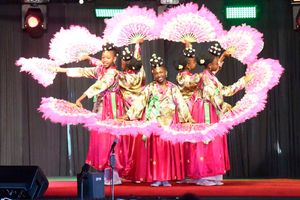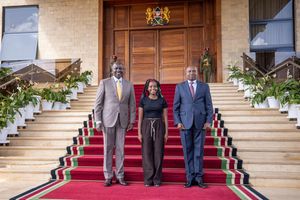
One of the sculptures in Eldoret city that drew public uproar.
Last week, Eldoret finally transitioned from a municipality to a city.
With an eye on all the opportunities and incentives that come with the attainment of city status, the leadership of Uasin Gishu County spared nothing to stage a memorable extravaganza, which culminated in climactic jubilation, as the festivity was catalysed by the triumphant return of our victorious Olympians.
Many have observed that going by ambient facts on the ground, Eldoret is far from ready to become a city, because it is deficient of all the phenomenal attributes that underpin the ascription of this definition upon expansive metropolitan spaces and their associated institutions.
Others, including the leadership of Uasin Gishu County, not only assert the contrary position but also argue that the acquisition of this status is purely dependent on the attainment of the formal parametres as inscribed in relevant ordinances.
Additionally, they propound a ‘self-fulfilling prophecy' theory, arguing that the attainment of the formal and legal status will unlock the opportunities and incentives necessary to transform ‘64’ from a de jure city, to a de facto city.
Whatever the case, it is clear that the leadership of the county coordinated with great determination to make a good feast of this cherished project.
If practised consistently as part of organisational culture and defining value, this ability to mobilise effectively in order to systematically proceed to achieve an objective, is exactly what it takes for the county to live up to its ambitions.
This proposition, which principally focuses on possibilities inherent in the positive strategic moment, is fundamentally contingent on astute awareness of what constitutes its negative strategic moment — and whether the leadership is equipped with the wherewithal to competently contend with it.
In the positive moment, Uasin Gishu struck all the right notes and made undeniable progress. In its negative moment, a combination of errors, failures and weaknesses conspired to undermine Eldoret's finest hour and gratuitously exposed its leadership and citizens to odium and ridicule.
On the eve of the jamboree, images of obscenely grotesque statuary and horribly inept artworks began to circulate within social and news media.
Disbelief swiftly gave way to horror as the nation learnt that the images depicted actual works that had been commissioned, approved, received and installed by the county government to honour our athletes and commemorate the attainment of city status.
Unfortunately, what passed for statues were unprepossessing effigies without the slightest semblance to any known person, and radically unlike any of our adored athletes.
These ghastly figures were smeared with garish paint and erected at junctions, roundabouts and other highly public spots on what appeared to be makeshift graves hastily laid in raw concrete.
Given that the stated intention of the county government was to honour elite athletes in keeping with its self-identity as the Home of Champions, these ludicrous exhibitions are utterly impermissible.
Another masterpiece, which turned out to have been intended to depict an ear of maize unsheathed to reveal a cob, at best instead resembled rotting and discoloured produce. Only parody and protest can accommodate the display of such dreadfully misdirected insults in the name of civic art; this is the extent of the failure.
There are many who do not appreciate the magnitude of the debacle, principally because they don't see art and artwork as a big deal.
Consequently, artists are marginal agents whose contribution is negligible. Discourse around the merits therefore is of minimal interest to ‘serious’ people, who define development and success in exclusive terms of infrastructure, commerce, manufacturing and so forth.
In all likelihood, then, positions in organisational structures established to attend to cultural and artistic endeavour have been relegated to sterile sinecures for well-connected ne'er-do-wells.
This gives rise to an organisational pathology that is indifferent to art, culture and aesthetics as vital values. Coupled with a runaway kickback culture which maximises illicit returns even from the lowest-bid contracts, it was inevitable that monstrously ugly works would be procured without any embarrassment.
Moreover, understanding the mind of the persons who imagined, created or approved these hideous will remain a vain struggle.
Art is representation. If the Eldoret statues woefully fell short in their endeavour to represent their putative subjects, they were astonishingly graphic and faithful in depicting the dysfunctional ecosystem which produced them. The inability to determine if a work even remotely represents its subject speaks to a disastrously deformed aesthetic.
Likewise, it is a painfully faithful metaphor of the extent to which the collapse of our representative framework has been normalised: do our elected leaders faithfully represent the will of the people or do they, like Eldoret’s unsightly statues, represent other, terribly malignant agencies?
Equally disconcerting is the other possibility. If we understand aesthetics as the analysis of values as experienced through the senses, just as literature, ethics, and even human behaviour are representative of values in action, might the Eldoret Statues represent something sinister, a fundamental ugliness of the psyche as a defining condition of our social and political system?
The writer is an Advocate of the High Court of Kenya










